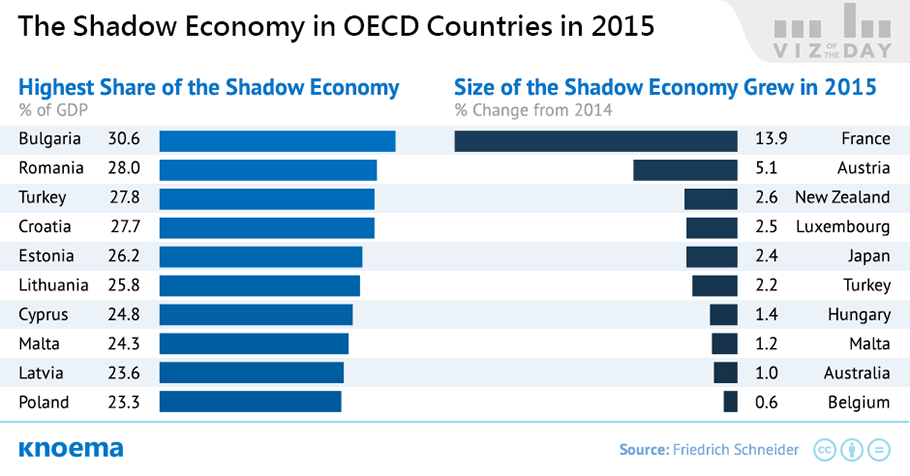The Shadow Economy in Europe and OECD Countries in 2003-2015
АрхивThe $9.7 trillion global shadow economy is the second largest economy in the world after the United States, according to the 2010 estimates of the black market for 162 countries. Still, as for the more recent study, the size of the underground economy in European and other OECD countries have been decreasing steadily since 2009 and continued shrinking in 2015 averaging to 16.7 percent of official GDP.
But this development was not uniform across individual countries: 10 out of 36 OECD countries experienced an increase in the black market size in 2015. The most significant upsurge of the unreported share of economic activities was observed in France, Austria, Luxembourg, and Japan. All of these countries saw an increase of individual income tax rate in the last two years that is one of the driving forces behind the expanding of the shadow economy.
 Try now
Try now
World in 2020
Access and compare forecasts for more than 50 indicators related to a country’s economic, demographic, and energy futures from leading international institutions. Assess the historic quality of forecasts with our Forecast Accuracy Tracking Tool™ and select the most accurate forecast to support your analysis.
Материалы по теме
GDP by Country | Statistics from IMF, 1980-2021
The visualizations on this page provide an access to the GDP data by country from the IMF's World Economic Outlook (WEO). The table shows the data on the GDP measured in current prices as well as based on purchasing power parities (PPP). Charts at the right visualize country's GDP presented in the table to enable a visual analysis of GDP dynamics. Take a look at other GDP-related dashboards: GDP: GDP by country from the World Bank | GDP by country from IMF | World GDP ranking | World GDP GDP per capita: GDP per capita by country from the World Bank | GDP per capita by country from IMF | World GDP per capita ranking See also: G20...
GDP per Capita by Country | Statistics from IMF, 1980-2021
The page provides an access to the GDP per capita data for different countries from the IMF's World Economic Outlook (WEO). The table shows the data on the GDP per capita measured in current prices as well as based on purchasing power parities (PPP). The chart at the right displays a country's GDP per capita as a share of GDP per capita of the United States. Take a look at other GDP-related dashboards: GDP: GDP by country from the World Bank | GDP by country from IMF | World GDP ranking | World GDP GDP per capita: GDP per capita by country from the World Bank | GDP per capita by country from IMF | World GDP per capita ranking See...
Мировой рейтинг стран по ВВП в 2015 году | Данные и Графики
GDP forecast for 2016 | Historical GDP (since 1970) | GDP (current US$) | GDP (current PPP int$) | GDP per capita | GDP per capita ranking | Real GDP growth | GDP by country GDP is the single most commonly referenced figure to cover the entirety of a national economy and the trajectory it is on in a single statistic. Measured annually, quarterly, or monthly, trends in GDP for a single country or comparisons among peer countries are often called out in popular press, sometimes with alarmist tones that can make one wonder why or how this single data point has taken on such importance. This is particularly the case in a world increasingly...
GDP by Country | Statistics from the World Bank, 1960-2015
GDP is the single most commonly referenced figure to cover the entirety of a national economy and its trajectory in a single statistic. Measured on the basis of purchasing power parities (PPP), GDP can be used for comparisons among peer countries. Using purchasing power parity with GDP involves a decrease of bias in economy estimation as PPP takes into account the relative cost of local goods, services and inflation rates of the country. Looking at the GDP figures from historic perspective allows understanding on what phase is the economy of a country at the moment. The data on GDP from the World Bank covers the period for the last half of...
